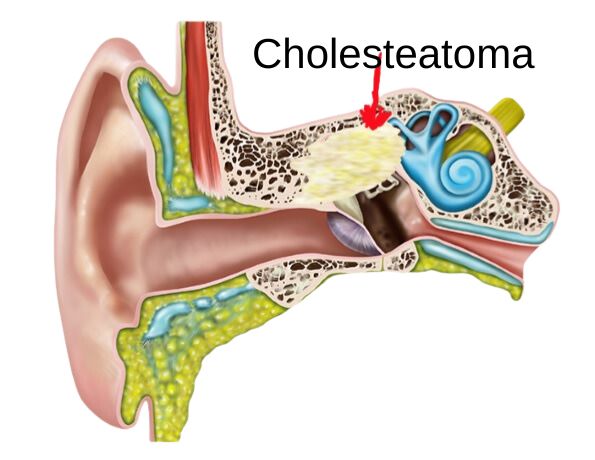Chronic inflammation of the middle ear can lead to various complications that significantly impact a person’s hearing and balance. One of the most concerning complications is the development of a cholesteatoma, an abnormal collection of cells within the ear that can have severe consequences if left untreated.
In a recent study published in Nature Communications, researchers from Osaka University have unveiled new insights into the causes of cholesteatomas, potentially paving the way for innovative therapies for those afflicted by this condition.

Chronic middle ear inflammation can lead to various complications that significantly impact a person’s hearing and balance. One of the most concerning complications is the development of a cholesteatoma, an abnormal collection of cells within the ear that can have severe consequences if left untreated. In a recent study published in Nature Communications, researchers from Osaka University have unveiled new insights into the causes of cholesteatomas, potentially paving the way for innovative therapies for those afflicted by this condition.
Understanding Cholesteatoma and Its Effects
What is a Cholesteatoma?
A cholesteatoma is a growth characterized by cysts or bumps that form within the ear. Comprising skin, collagen fibers, skin cells, fibroblasts, keratin, and dead tissue, cholesteatomas can cause detrimental complications if not addressed promptly.
Complications and Symptoms
If left untreated, cholesteatomas can lead to bone erosion, a process wherein the bone’s minerals and matrix are broken down, potentially causing severe damage to the ear’s structures. The consequences are far-reaching, causing symptoms such as:
Hearing Loss
Cholesteatomas can impede sound conduction and disrupt the delicate mechanisms of the inner ear, leading to varying degrees of hearing loss.
Dizziness and Imbalance
The presence of cholesteatomas can disrupt the ear’s balance system, resulting in dizziness and balance problems that can significantly impact daily activities.
Facial Paralysis
Cholesteatomas’ growth can exert pressure on facial nerves, causing facial paralysis and impacting a person’s ability to express emotions and perform facial movements.
Risk of Brain Infection
Perhaps the most concerning complication is the potential for a brain infection. If a cholesteatoma extends into the skull, it can introduce disease to the brain, posing a life-threatening risk.
Revealing the Underlying Cause
The Research Breakthrough
Researchers at Osaka University delved into the mechanisms behind cholesteatomas and their impact on bone erosion. By conducting an in-depth study using single-cell RNA sequencing analysis, they identified a specific type of cell responsible for triggering bone erosion, termed “osteoclastogenic fibroblasts.”
Activin A: The Key Player
The study unveiled a critical factor in bone erosion: activin A. This molecule is known to regulate various physiological functions within the body. The researchers discovered that osteoclastogenic fibroblasts associated with cholesteatomas express an abundance of activin A. This molecule initiates a process wherein specialized cells break down and absorb bone minerals and matrix, ultimately leading to bone erosion.
Implications for Treatment
By establishing the connection between activin A and bone erosion in cholesteatomas, the study has opened up new possibilities for treatment. Targeting activin A could potentially prevent or mitigate bone erosion, offering an alternative to the current surgical approach.
The Road Ahead: New Hope for Treatment
Current Treatment Landscape
As of now, complete surgical removal is the most effective treatment for cholesteatomas. However, the recurrence of cholesteatomas even after surgical intervention underscores the need for a deeper understanding of the condition’s underlying causes.
Promising Therapeutic Avenues
The discovery of activin A’s role in bone erosion presents a promising avenue for novel medical treatments. By targeting this molecule, researchers and medical professionals could potentially develop groundbreaking therapies that address cholesteatomas at their root cause.
Conclusion
Chronic middle ear inflammation can lead to serious complications like cholesteatomas, which can cause bone erosion and various detrimental effects on hearing and balance. A recent study from Osaka University has shed light on the connection between activin A and bone erosion, offering hope for future treatments beyond traditional surgery. With this newfound understanding, medical advancements may pave the way for more effective and less invasive approaches to managing cholesteatomas.
Frequently Asked Questions
What is a cholesteatoma?
A cholesteatoma is an abnormal collection of cells within the ear, often causing complications such as bone erosion and hearing loss.
What are the symptoms of cholesteatoma-related bone erosion?
Cholesteatomas can lead to symptoms like hearing loss, dizziness, imbalance, facial paralysis, and even a risk of brain infection.
How does activin A contribute to bone erosion in cholesteatomas?
Activin A is a molecule that triggers bone resorption, leading to bone erosion in cholesteatomas.
What is the current treatment for cholesteatomas?
Surgical removal is the primary treatment, but the recurrence of cholesteatomas post-surgery highlights the need for alternative approaches.
How does the Osaka University study offer hope for treatment?
The study’s discovery of activin A’s role opens up possibilities for targeted therapies that address the root cause of cholesteatomas, potentially revolutionizing treatment options.




